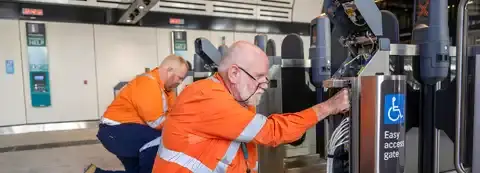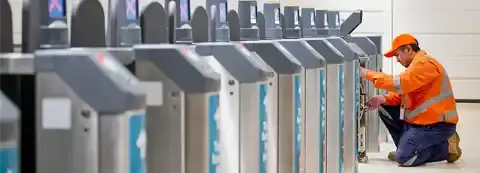
Jeffrey Lowinger
In many respects, the world’s changing faster now than it has ever before.
The pandemic changed the rules of the game; markets are unpredictable; business models need to be rewritten, and customer preferences are shifting daily.
While transit agencies responded fast to the crisis brought on by the virus, putting in place safety protocols and optimizing services to best suit the current climate, the way we travel and commute will never be the same.
If we are to engineer a better future, one where public transportation continues to act as an agent of change, it’s important to consider the long-term implications COVID-19 will have on the transit industry and the ways in which cities need to address them.
During a zoom call with a global partner, I was asked some pretty frank questions about NextCity and the future of mobility and I knew it was imperative I share those answers. Below is an excerpt of our call:
Q: Is my city a NextCity?
Do you wake up to personalized, real-time travel updates on your phone? Does your journey include a combination of private and public transit modes working in unison to optimize your personal preferences, taking advantage of many travel options in your neighborhood? Do you receive a promotional voucher to your favorite retailer or coffee shop when you adjust your travel time to avoid peak hours? If you answered “no" to any of these questions, then we still have opportunities to make your city a ‘NextCity’.
NextCity is not just for large or megacities. Any city can be a NextCity.
NextCity is about taking your city to the next level – to be better, healthier, smarter.
NextCity is our vision for city management and integrated traveler payment and information that centers on three core principles:
- Predict the Journey: We want to get you there by way of a “predictable journey”.
- Enable Rider Confidence: We want to enable transportation agencies/departments with technologies to create a higher-level of safety.
- Simplify the Experience: We want to allow riders to understand their multimodal travel expenses and balances by way of one account or one app when it comes to regional integration.
Some refer to this concept as Mobility-as-a-Service (MaaS).
Q: How does this vision differ from what the rest of the industry is saying?
The vision goes beyond individual solutions that address a single problem.
We’re focused on long-term change on a multimodal level.
NextCity is focused on managing the multimodal network – managing today’s congestion and alleviating today’s pain points.
For example, we propose building a more resilient network that inspires collaboration between public and private mobility service providers and challenges the siloed approach some are used to.
We see NextCity as a safe environment for transport staff and travelers; a trusted network of modes to encourage ridership; and equitable, sustainable, and economically viable networks that promote prosperity.
Q: How is COVID-19 impacting NextCity in the short term?
The origin of NextCity placed public transit at the heart of mobility, empowering the public sector to define policy and truly own how MaaS uniquely addresses the needs of the region. This continues to be the strongest foundation for MaaS to become a reality.
Due to the pandemic, we are seeing a fall in ridership that will take some time to rebound. With the rebound, more frictionless solutions such as contactless open payment will be favored.
In the meantime, we’re also likely to experience an influx of low-occupancy passenger vehicles and an increase in active mobility modes such as scooters, bikes, and walking as travelers adopt new routines.
In all honesty, large/megacities cannot operate without mass transit. Ridership will come back. And while it is coming back, it’s time to put emphasis on enabling confidence and managing congestion.
Cities will need flexibility and resilience to adapt and scale their networks.
They will need to meet ever-changing needs and open the doors for new mobility approaches. And they will need to act quickly, much quicker than before.
Q: What does the future hold for mobility?
In the future, all modes of transportation will act as one holistic ecosystem. Travelers will be encouraged and rewarded for taking advantage of the diversity of options. Transport modes will be synchronized to reduce strain on the network when one reaches capacity.
Intelligent journey planning will be flexible enough to quickly adapt to changing priorities, such as length of commute, convenience, number of changes - or, when needed, passenger safety.
Journeys will be tailored to the traveler’s preferences and mobility options will be optimally applied where they best fit the need addressing the first, middle and last miles.
Q. Will cars become obsolete?
No, and rightly so. Cars will continue to play an important role in the post-pandemic world, at least for the time being.
With remote work, a McKinsey study noted a drop in vehicle-miles-traveled (VMT). The downward trend might continue if remote work continues. But this trend will have less impact if more people move from cities to suburbs—thereby increasing VMT and shifting the congestion to the next outer ring – from the city center to suburbs.
While car-sharing services took a hit, we predict they will recover quickly and with a renewed force.
We’re noticing a renewed interest in the adoption of electric and hybrid electric vehicles, which are a key component of meeting critical environmental goals for many countries around the globe.
Constantly evolving traffic management technologies will enable effective and safe control of intersections and offer advanced congestion management, helping integrate vehicle traffic seamlessly into the wider mobility picture.
Schemes such as road user charging will provide cities with a means to raise new revenues while charging users equitably and helping fund new infrastructure projects that create safe alternatives to vehicle transport.
Furthermore, advanced technologies such as artificial intelligence enhance the system bridging the requirements of cars and the overall network. For instance, traffic cameras with computer vision for detection and classification of vehicles will help to optimize street flow while ensuring the safety of vulnerable road users such as cyclists and pedestrians.
Q. Are there benefits even if I’m no longer commuting?
Definitely. This is the freedom to redefine your daily routine and find new ways to enjoy your free time.
As companies consider permanently adopting flexible work-from-home policies, this shift provides hope that the daily commute can be minimized.
It is yet to be seen if this will result in any long-term noticeable change in traffic on the roads or in reduced congestion. So far, the trends are showing the opposite as vehicular traffic in many cities has already exceeded pre-COVID levels.
We do hope our cities will have a lasting impact towards becoming more environmentally friendly, with cleaner air and less noise pollution as was experienced during the height of the pandemic, but other factors including an increase in e-commerce delivery (food; goods; groceries) will be a key factor in this.
With daily commuting out of the picture, we all have a chance to repurpose that time into something else.
There is a genuine benefit in minimizing single-occupant commuting for both the environment and self. I suggest focusing on the predictable journey and repurposing those extra 1-2 hours in your day.
Q. We’re all hoping for a better future, but what do you mean by that?
Cubic is envisioning a future where cities can adapt to changing needs quickly with coordinated, on-demand mobility systems, addressing the growing need for intelligent, real-time, user-centric, and truly connected transportation management.
It’s our job to provide enabling technology; to bring consumer confidence back.
With our global partners, we can and will help our customers accelerate consumer confidence.
We must come to terms with the fact that the transit industry will feel the effects of COVID-19 for months on end.
Our industry is evolving, and we must elevate our work to advance transportation’s role in creating resilient cities that promote excellence, prosperity and equity.
*First published on LinkedIn.
Jeffrey Lowinger is the senior vice president of Cubic Corporation and president of Cubic Transportation Systems (CTS). He will be responsible for overseeing the business’ continued growth and advancing Cubic’s NextCity™ strategic priorities.
Prior to joining Cubic, Lowinger was the president of the eMobility segment for Eaton Corporation, a new organic growth segment announced in March of 2018 to provide intelligent power electronics, power systems and advanced power distribution, in addition to circuit protection products and solutions for the automotive and commercial vehicle industry. Since the launch of the segment, the business achieved over $450 million in mature year revenue of new business. He oversaw the global profit and loss (P&L) for sales, marketing, development, production and services for all power management technologies for on- and off-road vehicles. Prior to leading eMobility, Lowinger served as the senior vice president of engineering and chief technology officer for the company’s industrial sector where he was responsible for leading the technology maturation for the aerospace, vehicle and hydraulics portfolio as well as overseeing the commercialization for new product development for specific customer applications.
Lowinger successfully completed a 25-year career at Boeing where he held several engineering leadership roles managing complex hardware/software development programs for all key rotorcraft programs. He was also the executive vice president of engineering, Xworx and commercial business at Bell Helicopter, where he oversaw the $1.5 billion global commercial business in addition to leading innovation and technology for Bell’s Xworx organization.
He is active in promoting science and technology and has served on the advisory boards at Rutgers University, Texas Christian University, Penn State University and Concordia University. He holds a bachelor’s degree in electrical engineering from Rutgers University. Lowinger also completed executive education programs at Thunderbird School of Global Management at Arizona State University and Fuqua School of Business at Duke University.



